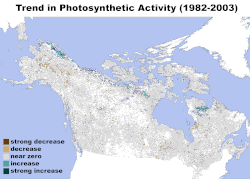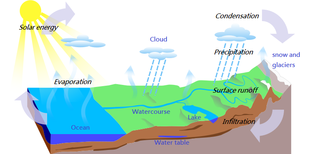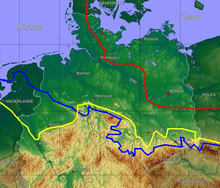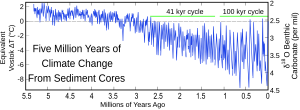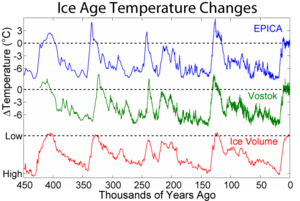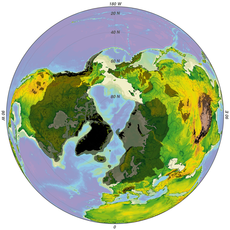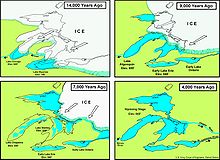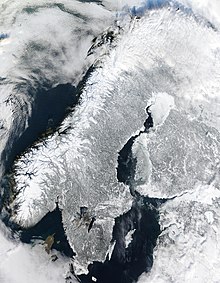Rainforest ecosystems are rich in biodiversity. This is the Gambia River in Senegal's Niokolo-Koba National Park.
This article is about climate change and ecosystems. Future climate change is expected to affect particular ecosystems, including tundra, mangroves, coral reefs, and caves.
General
Unchecked global warming could affect most terrestrial ecoregions. Increasing global temperature means that ecosystems will change; some species are being forced out of their habitats (possibly to extinction)
because of changing conditions, while others are flourishing. Secondary
effects of global warming, such as lessened snow cover, rising sea
levels, and weather changes, may influence not only human activities but
also the ecosystem.
For the IPCC Fourth Assessment Report, experts assessed the literature on the impacts of climate change on ecosystems. Rosenzweig et al.
(2007) concluded that over the last three decades, human-induced
warming had likely had a discernible influence on many physical and
biological systems (p. 81). Schneider et al. (2007) concluded, with very high confidence, that regional temperature trends had already affected species and ecosystems around the world (p. 792).
With high confidence, they concluded that climate change would result
in the extinction of many species and a reduction in the diversity of
ecosystems (p. 792).
- Terrestrial ecosystems and biodiversity: With a warming of 3 °C, relative to 1990 levels, it is likely that global terrestrial vegetation would become a net source of carbon (Schneider et al., 2007:792). With high confidence, Schneider et al. (2007:788) concluded that a global mean temperature increase of around 4 °C (above the 1990-2000 level) by 2100 would lead to major extinctions around the globe.
- Marine ecosystems and biodiversity: With very high confidence, Schneider et al. (2007:792) concluded that a warming of 2 °C above 1990 levels would result in mass mortality of coral reefs globally. In addition, several studies dealing with planktonic organisms and modelling have shown that temperature plays a transcendental role in marine microbial food webs, which may have a deep influence on the biological carbon pump of marine planktonic pelagic and mesopelagic ecosystems.
- Freshwater ecosystems: Above about a 4 °C increase in global mean temperature by 2100 (relative to 1990-2000), Schneider et al. (2007:789) concluded, with high confidence, that many freshwater species would become extinct.
Impacts
Studying the association between Earth climate and extinctions over the past 520 million years, scientists from the University of York
write, "The global temperatures predicted for the coming centuries may
trigger a new ‘mass extinction event’, where over 50 per cent of animal
and plant species would be wiped out."
Many of the species at risk are Arctic and Antarctic fauna such as polar bears and emperor penguins. In the Arctic, the waters of Hudson Bay are ice-free for three weeks longer than they were thirty years ago, affecting polar bears, which prefer to hunt on sea ice. Species that rely on cold weather conditions such as gyrfalcons, and snowy owls that prey on lemmings that use the cold winter to their advantage may be hit hard. Marine invertebrates enjoy peak growth at the temperatures they have adapted to, regardless of how cold these may be, and cold-blooded animals found at greater latitudes and altitudes generally grow faster to compensate for the short growing season. Warmer-than-ideal conditions result in higher metabolism and consequent reductions in body size despite increased foraging, which in turn elevates the risk of predation. Indeed, even a slight increase in temperature during development impairs growth efficiency and survival rate in rainbow trout.
Rising temperatures are beginning to have a noticeable impact on birds, and butterflies
have shifted their ranges northward by 200 km in Europe and North
America. Plants lag behind, and larger animals' migration is slowed down
by cities and roads. In Britain, spring butterflies are appearing an
average of 6 days earlier than two decades ago.
A 2002 article in Nature
surveyed the scientific literature to find recent changes in range or
seasonal behaviour by plant and animal species. Of species showing
recent change, 4 out of 5 shifted their ranges towards the poles or
higher altitudes, creating "refugee species". Frogs were breeding,
flowers blossoming and birds migrating an average 2.3 days earlier each
decade; butterflies, birds and plants moving towards the poles by 6.1 km
per decade. A 2005 study concludes human activity is the cause of the
temperature rise and resultant changing species behaviour, and links
these effects with the predictions of climate models to provide validation for them. Scientists have observed that Antarctic hair grass is colonizing areas of Antarctica where previously their survival range was limited.
Mechanistic studies have documented extinctions due to recent climate change: McLaughlin et al. documented two populations of Bay checkerspot butterfly being threatened by precipitation change.
Parmesan states, "Few studies have been conducted at a scale that encompasses an entire species" and McLaughlin et al. agreed "few mechanistic studies have linked extinctions to recent climate change." Daniel Botkin and other authors in one study believe that projected rates of extinction are overestimated. For "recent" extinctions, see Holocene extinction.
Many species of freshwater and saltwater plants and animals are
dependent on glacier-fed waters to ensure a cold water habitat that they
have adapted to. Some species of freshwater fish need cold water to
survive and to reproduce, and this is especially true with salmon and cutthroat trout. Reduced glacier runoff can lead to insufficient stream flow to allow these species to thrive. Ocean krill, a cornerstone species, prefer cold water and are the primary food source for aquatic mammals such as the blue whale. Alterations to the ocean currents, due to increased freshwater inputs from glacier melt, and the potential alterations to thermohaline circulation of the worlds oceans, may affect existing fisheries upon which humans depend as well.
The white lemuroid possum, only found in the Daintree
mountain forests of northern Queensland, may be the first mammal species
to be driven extinct by global warming in Australia. In 2008, the white
possum has not been seen in over three years. The possums cannot
survive extended temperatures over 30 °C (86 °F), which occurred in
2005.
A 27-year study of the largest colony of Magellanic penguins
in the world, published in 2014, found that extreme weather caused by
climate change is responsible for killing 7% of penguin chicks per year
on average, and in some years studied climate change accounted for up to
50% of all chick deaths. Since 1987, the number of breeding pairs in the colony has reduced by 24%.
Climate change is leading to a mismatch between the snow camouflage of arctic animals such as snowshoe hares with the increasingly snow-free landscape.
Forests
Change in Photosynthetic Activity in Northern Forests 1982-2003; NASA Earth Observatory
Pine forests in British Columbia have been devastated by a pine beetle
infestation, which has expanded unhindered since 1998 at least in part
due to the lack of severe winters since that time; a few days of extreme
cold kill most mountain pine beetles and have kept outbreaks in the
past naturally contained. The infestation, which (by November 2008) has
killed about half of the province's lodgepole pines (33 million acres or
135,000 km²) is an order of magnitude larger than any previously recorded outbreak.
One reason for unprecedented host tree mortality may be due to that the
mountain pine beetles have higher reproductive success in lodgepole
pine trees growing in areas where the trees have not experienced
frequent beetle epidemics, which includes much of the current outbreak
area. In 2007 the outbreak spread, via unusually strong winds, over the continental divide to Alberta. An epidemic also started, be it at a lower rate, in 1999 in Colorado, Wyoming, and Montana. The United States forest service predicts that between 2011 and 2013 virtually all 5 million acres (20,000 km2) of Colorado’s lodgepole pine trees over five inches (127 mm) in diameter will be lost.
As the northern forests are a carbon sink,
while dead forests are a major carbon source, the loss of such large
areas of forest has a positive feedback on global warming. In the worst
years, the carbon emission due to beetle infestation of forests in
British Columbia alone approaches that of an average year of forest
fires in all of Canada or five years worth of emissions from that country's transportation sources.
Besides the immediate ecological and economic impact, the huge
dead forests provide a fire risk. Even many healthy forests appear to
face an increased risk of forest fires
because of warming climates. The 10-year average of boreal forest
burned in North America, after several decades of around 10,000 km² (2.5
million acres), has increased steadily since 1970 to more than
28,000 km² (7 million acres) annually.
Though this change may be due in part to changes in forest management
practices, in the western U.S., since 1986, longer, warmer summers have
resulted in a fourfold increase of major wildfires and a sixfold
increase in the area of forest burned, compared to the period from 1970
to 1986. A similar increase in wildfire activity has been reported in
Canada from 1920 to 1999.
Forest fires in Indonesia
have dramatically increased since 1997 as well. These fires are often
actively started to clear forest for agriculture. They can set fire to
the large peat bogs in the region and the CO₂released by these peat bog
fires has been estimated, in an average year, to be 15% of the quantity
of CO₂produced by fossil fuel combustion.
A 2018 study found that trees grow faster due to increased carbon
dioxide levels, however, the trees are also eight to twelve percent
lighter and denser since 1900. The authors note, "Even though a greater
volume of wood is being produced today, it now contains less material
than just a few decades ago."
Mountains
Mountains
cover approximately 25 percent of earth's surface and provide a home to
more than one-tenth of global human population. Changes in global
climate pose a number of potential risks to mountain habitats. Researchers expect that over time, climate change will affect mountain and lowland ecosystems, the frequency and intensity of forest fires, the diversity of wildlife, and the distribution of fresh water.
Studies suggest a warmer climate in the United States would
cause lower-elevation habitats to expand into the higher alpine zone.
Such a shift would encroach on the rare alpine meadows and other
high-altitude habitats. High-elevation plants and animals have limited
space available for new habitat as they move higher on the mountains in
order to adapt to long-term changes in regional climate.
Changes in climate will also affect the depth of the mountains
snowpacks and glaciers. Any changes in their seasonal melting can have
powerful impacts on areas that rely on freshwater runoff
from mountains. Rising temperature may cause snow to melt earlier and
faster in the spring and shift the timing and distribution of runoff.
These changes could affect the availability of freshwater for natural
systems and human uses.
Oceans
Ocean Acidification
Estimated
annual mean sea surface anthropogenic dissolved inorganic carbon
concentration for the present day (normalised to year 2002) from the
Global Ocean Data Analysis Project v2 (GLODAPv2) climatology.
Annual mean sea surface dissolved oxygen from the World Ocean Atlas 2009. Dissolved oxygen here is in mol O2m-3.
Ocean acidification poses a severe threat to the earth's natural process of regulating atmospheric C02 levels, causing a decrease in water's ability to dissolve oxygen and created oxygen-vacant bodies of water called "dead zones." The ocean absorbs up to 55% of atmospheric carbon dioxide, lessoning the effects of climate change. This diffusion of carbon dioxide into seawater results in three acidic molecules: bicarbonate ion (HCO3-), aqueous carbon dioxide (CO2aq), and carbonic acid (H2CO3).
These three compounds increase the ocean's acidity, decreasing its ph
by up to 0.1 per 100ppm (part per million) of atmospheric CO2.
The increase of ocean acidity also decelerates the rate of
calcification in salt water, leading to slower growing reefs which
support a whopping 25% of marine life.
As seen with the great barrier reef, the increase in ocean acidity in
not only killing the coral, but also the wildly diverse population of
marine inhabitants which coral reefs support.
Dissolved Oxygen
Another
issue faced by increasing global temperatures is the decrease of the
ocean's ability to dissolve oxygen, one with potentially more severe
consequences than other repercussions of global warming.
Ocean depths between 100 meters and 1,000 meters are known as "oceanic
mid zones" and host a plethora of biologically diverse species, one of
which being zooplankton. Zooplankton feed on smaller organisms such as phytoplankton, which are an integral part of the marine food web.
Phytoplankton perform photosynthesis, receiving energy from light, and
provide sustenance and energy for the larger zooplankton, which provide
sustenance and energy for the even larger fish, and so on up the food
chain.
The increase in oceanic temperatures lowers the ocean's ability to
retain oxygen generated from phytoplankton, and therefore reduces the
amount of bioavailable oxygen that fish and other various marine
wildlife rely on for their survival.
This creates marine dead zones, and the phenomenon has already
generated multiple marine dead zones around the world, as marine
currents effectively "trap" the deoxygenated water.
Combined Impact
Eventually
the planet will warm to such a degree that the ocean's ability to
dissolve water will no longer exist, resulting in a worldwide dead zone.
Dead zones, in combination with ocean acidification, will usher in an
era where marine life in most forms will cease to exist, causing a sharp
decline in the amount of oxygen generated through bio carbon
sequestration, perpetuating the cycle.
This disruption to the food chain will cascade upward, thinning out
populations of primary consumers, secondary consumers, tertiary
consumers, etc., as primary consumers being the initial victims of these
phenomenon.
Fresh Water
Disruption to Water-Cycle
The Water Cycle
Fresh water covers only 0.8% of the Earth's surface, but contains up to 6% of all life on the planet.
However, the impacts climate change deal to its ecosystems are often
overlooked. Very few studies showcase the potential results of climate
change on large-scale ecosystems which are reliant on freshwater, such
as river ecosystems, lake ecosystems, desert ecosystems, etc. However, a
comprehensive study published in 2009 delves into the effects to be
felt by lotic (flowing) and lentic (still) freshwater ecosystems in the
American Northeast. According to the study, persistent rainfall,
typically felt year round, will begin to diminish and rates of
evaporation will increase, resulting in drier summers and more sporadic
periods of precipitation throughout the year.
Additionally, a decrease in snowfall is expected, which leads to less
runoff in the spring when snow thaws and enters the watershed, resulting
in lower-flowing fresh water rivers.
This decrease in snowfall also leads to increased runoff during winter
months, as rainfall cannot permeate the frozen ground usually covered by
water-absorbing snow. These effects on the water cycle will wreak havoc for indigenous species residing in fresh water lakes and streams.
Salt Water Contamination and Cool Water Species
Eagle River in central Alaska, home to various indigenous freshwater species.
Species of fish living in cold or cool water can see a reduction in
population of up to 50% in the majority of U.S. fresh water streams,
according to most climate change models.
The increase in metabolic demands due to higher water temperatures, in
combination with decreasing amounts of food will be the main
contributors to their decline.
Additionally, many fish species (such as salmon) utilize seasonal water
levels of streams as a means of reproducing, typically breeding when
water flow is high and migrating to the ocean after spawning.
Because snowfall is expected to be reduced due to climate change, water
runoff is expected to decrease which leads to lower flowing streams,
effecting the spawning of millions of salmon.
To add to this, rising seas will begin to flood coastal river systems,
converting them from fresh water habitats to saline environments where
indigenous species will likely perish. In southeast Alaska, the sea
rises by 3.96cm/year, redepositing sediment in various river channels
and bringing salt water inland.
This rise in sea level not only contaminates streams and rivers with
saline water, but also the reservoirs they are connected to, where
species such as Sockeye Salmon live. Although this species of Salmon can
survive in both salt and fresh water, the loss of a body of fresh water
stops them from reproducing in the spring, as the spawning process
requires fresh water.
Undoubtedly, the loss of fresh water systems of lakes and rivers in
Alaska will result in the imminent demise of the state's once-abundant
population of salmon.
Combined Impact
In
general, as the planet warms, the amount of fresh water bodies across
the planet decreases, as evaporation rates increase, rain patterns
become more sporadic , and watershed patterns become fragmented,
resulting in less cyclical water flow in river and stream systems. This
disruption to fresh water cycles disrupts the feeding, mating, and
migration patterns of organisms reliant on fresh water ecosystems.
Additionally, the encroachment of saline water into fresh water river
systems endangers indigenous species which can only survive in fresh
water.
Ecological productivity
- According to a paper by Smith and Hitz (2003:66), it is reasonable to assume that the relationship between increased global mean temperature and ecosystem productivity is parabolic. Higher carbon dioxide concentrations will favourably affect plant growth and demand for water. Higher temperatures could initially be favourable for plant growth. Eventually, increased growth would peak then decline.
- According to IPCC (2007:11), a global average temperature increase exceeding 1.5–2.5 °C (relative to the period 1980–99), would likely have a predominantly negative impact on ecosystem goods and services, e.g., water and food supply.
- Research done by the Swiss Canopy Crane Project suggests that slow-growing trees only are stimulated in growth for a short period under higher CO2 levels, while faster growing plants like liana benefit in the long term. In general, but especially in rainforests, this means that liana become the prevalent species; and because they decompose much faster than trees their carbon content is more quickly returned to the atmosphere. Slow growing trees incorporate atmospheric carbon for decades.
Species migration
In 2010, a gray whale
was found in the Mediterranean Sea, even though the species had not
been seen in the North Atlantic Ocean since the 18th century. The whale
is thought to have migrated from the Pacific Ocean via the Arctic.
Climate Change & European Marine Ecosystem Research (CLAMER) has also reported that the Neodenticula seminae
alga has been found in the North Atlantic, where it had gone extinct
nearly 800,000 years ago. The alga has drifted from the Pacific Ocean
through the Arctic, following the reduction in polar ice.
In the Siberian subarctic,
species migration is contributing to another warming albedo-feedback,
as needle-shedding larch trees are being replaced with dark-foliage
evergreen conifers which can absorb some of the solar radiation that
previously reflected off the snowpack beneath the forest canopy.
It has been projected many fish species will migrate towards the North
and South poles as a result of climate change, and that many species of
fish near the Equator will go extinct as a result of global warming.
Migratory birds are especially at risk for endangerment due to
the extreme dependability on temperature and air pressure for migration,
foraging, growth, and reproduction. Much research has been done on the
effects of climate change on birds, both for future predictions and for
conservation. The species said to be most at risk for endangerment or
extinction are populations that are not of conservation concern.
It is predicted that a 3.5 degree increase in surface temperature will
occur by year 2100, which could result in between 600 and 900
extinctions, which mainly will occur in the tropical environments.
Agriculture
Droughts have been occurring more frequently because of global
warming and they are expected to become more frequent and intense in
Africa, southern Europe, the Middle East, most of the Americas,
Australia, and Southeast Asia.
Their impacts are aggravated because of increased water demand,
population growth, urban expansion, and environmental protection efforts
in many areas. Droughts result in crop failures and the loss of pasture grazing land for livestock.
Droughts are becoming more frequent and intense in arid and semiarid
western North America as temperatures have been rising, advancing the
timing and magnitude of spring snow melt floods and reducing river flow
volume in summer. Direct effects of climate change include increased
heat and water stress, altered crop phenology,
and disrupted symbiotic interactions. These effects may be exacerbated
by climate changes in river flow, and the combined effects are likely to
reduce the abundance of native trees in favor of non-native herbaceous
and drought-tolerant competitors, reduce the habitat quality for many
native animals, and slow litter decomposition and nutrient cycling.
Climate change effects on human water demand and irrigation may
intensify these effects.
By 2012, North American corn prices had risen to a record $8.34 per
bushel in August, leaving 20 of the 211 U.S. ethanol fuel plants idle.

